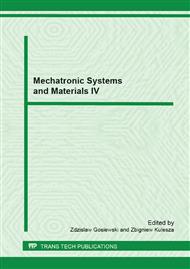p.406
p.412
p.421
p.427
p.433
p.439
p.445
p.451
p.457
Active Vibration Control Method for Space Mechanical Structure with Piezostacks
Abstract:
Mechanical structures are spatial, three-dimensional (3D) systems of distributed parameters. They present quite complicated plants, if methods of control systems theory are applied. The design process of the vibration control system for such plants is extremely difficult and requires an extensive heuristic knowledge. The subject of the control system is to eliminate the vibrations of the free end at the plane parallel to the foundation Similar problems are met, when the stabilization of robot arms, antennas, satellite solar batteries or slender skyscrapers is considered. In the paper we have presented the 3D bar structure with sticked parallel two piezo-stacks into bars. Recall piezo-elements are actuators, but sensors are two eddy-current sensors located in near free end the structure in perpendicular directions X and Y. Thus the whole structure is TITO (Two Input Two Output) system. For such system the control law was designed with used LQR controller. Above controller was designed for coupled and decoupled system also. In both case a correct damp and very short period of the vibration were criteria to choose the controller parameters. All investigations were carried out in two steps. In the first step control laws were designed in computer simulation. In the second step these control laws were verified experimentally on the laboratory stand by using DSP. Finally, desired control laws were compared.
Info:
Periodical:
Pages:
433-438
Citation:
Online since:
March 2013
Authors:
Price:
Сopyright:
© 2013 Trans Tech Publications Ltd. All Rights Reserved
Share:
Citation:


